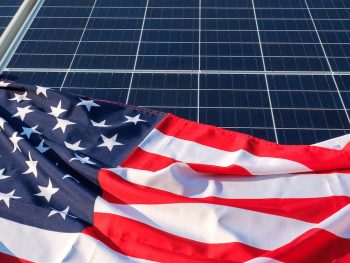The lowdown on EV landscapes in three key global markets
Dunstan Power, MD of smart EV charging firm Versinetic, takes a look at what’s happening in three key EV markets – the UK, China and the USA – to give a snapshot of where they are currently on their respective EV journeys.
Enter the dragon
 With figures like these and an ability to undercut US manufacturers, Chinese EVs are racing ahead of their American counterparts in the market. However, looking at the saturated, domestic market, Chinese EV automakers, facing intense competition, are exporting their EVs to the Southeast Asian market with success – capturing 80% of the Thai market share.
With figures like these and an ability to undercut US manufacturers, Chinese EVs are racing ahead of their American counterparts in the market. However, looking at the saturated, domestic market, Chinese EV automakers, facing intense competition, are exporting their EVs to the Southeast Asian market with success – capturing 80% of the Thai market share.
In terms of China’s success, the Government has played a key role in ensuring supply and demand are maintained, as well as offering incentives including but not limited to procurement contracts, generous subsidies and tax breaks. This has resulted in a spate of EV automakers and an emerging young EV buyer market. Chinese automakers are not only undercutting their US counterparts but they are 30% faster in developing vehicles. For example, leading manufacturer BYD’s Seagull hatchback comes in at under $10,000 (£7,832 / €9,148). A similarly specced US model would cost approximately $50,000 (£39,163/ €45,739). Chinese manufacturers also operate on a make-now, update-later basis when it comes to their EVs. They release the minimally viable product to the market and use OTA updates to upgrade the technology in the vehicles later.
As well as record EV sales, China has also taken big strides with its charging infrastructure, with 65% of the world’s public EV charging stations existing in China. However, charging operators are struggling to make profits due to the underutilisation of public charging posts, which, on average, are used once a day.
The American way
 In the US, EV sales are growing overall, up 40% at the end of 2023 from the same period in 2022, with total sales reaching 1.2m vehicles. Some automakers, including Mercedes and Tesla, have reported healthy growth, and others such as Ford have pressed pause on their plans for certain EV models. These mixed messages from automakers may be confusing for purchasers on the cusp of switching over to electric vehicles, potentially causing them to hang onto their ICE for a little longer. Elsewhere, high price points in comparison to Chinese EVs are frustrating US consumers.
In the US, EV sales are growing overall, up 40% at the end of 2023 from the same period in 2022, with total sales reaching 1.2m vehicles. Some automakers, including Mercedes and Tesla, have reported healthy growth, and others such as Ford have pressed pause on their plans for certain EV models. These mixed messages from automakers may be confusing for purchasers on the cusp of switching over to electric vehicles, potentially causing them to hang onto their ICE for a little longer. Elsewhere, high price points in comparison to Chinese EVs are frustrating US consumers.
Issues such as range anxiety and where to charge EVs may still be perceived issues dissuading Americans from electric vehicle ownership. Recently, Energy Secretary Jennifer Granholm addressed the concerns of would-be EV owners on ABC News, giving her views on charging anxiety and vehicle price points whilst also highlighting EVs’ environmental and cost benefits, and advising of a tax credit for EV owners. The Government’s push to grow US electric vehicle numbers also aims to grow manufacturing jobs and decrease the country’s reliance on Chinese parts.
In her interview, Granholm does concede that there is currently an insufficient number of charging stations which needs to change and states there will be a focus on increasing provisions. According to experts, there are approximately 150,000 EV chargers in the US but the market needs to have more than a million new public EV chargers to accommodate the rise of electric vehicles within the next six years. With growth of EVs slow and consumers undecided whether to go to EVs, the charger to EV ratio may present an impasse, with consumers waiting until there are more EV chargers, while charging providers are unwilling to install more points until there are more EV drivers.
Elsewhere in the US, EV charging seems to be making headlines with Tesla recently stating it would open its superchargers to other cars. Car manufacturers such as GM and Ford have taken up its North American Charging Standard (NACS) in their droves, meaning it is the charging standard that many are moving towards, preferring it to government endorsed Combine Charging System (CCS). Currently, the industry’s main standards organisation has recently advised that NACS is now the main EV charger type. It means Tesla, with its best-selling EVs, now has the smallest and lightest charging standard and the largest charging network in the world.
While the US is trying to protect and grow its EV industry, it is eyeing Chinese manufacturers warily, with Biden’s announcement this year of an investigation into Chinese-made smart cars that may be collecting sensitive data on their American drivers. The investigation could result in new rules to stop software in EVs and connected vehicles to gather personal information. There is little likelihood of Chinese EV carmakers entering the US market anytime soon, however, thanks to the Biden administration carrying on Trump’s 27.5% tariff on Chinese-made cars.
Imperial past, electric future
 In the UK, there are approximately 1,730,000 plug-in cars, with over 1,000,000 battery-electric cars and 645,000 PHEVs registered. The number of new battery electric cars registered by the end of 2023 rose by 18% year on year. Growth is slow, with private buyers not adopting at the same rate as fleet or business owners.
In the UK, there are approximately 1,730,000 plug-in cars, with over 1,000,000 battery-electric cars and 645,000 PHEVs registered. The number of new battery electric cars registered by the end of 2023 rose by 18% year on year. Growth is slow, with private buyers not adopting at the same rate as fleet or business owners.
Pricing could have an effect on growth. A new electric car, on average, is priced at 36% higher than its fossil-fuelled counterparts, this added to any existing concerns drivers may have about charging and repairing their EVs or making it to their destinations may all be causing the delay. To incentivise electric drivers, automakers and retailers are lowering prices or applying higher discounts to encourage private buyers to reach for their wallets. However, despite the discounts, the cost of an EV is still higher than its petrol or diesel equivalent. With the UK government now delaying its ban on petrol and diesel car sales until 2035, consumers may feel confused about the announcement and delay their electric vehicle purchases for a little longer.
Despite the slow growth of EV uptake, the UK EV market is still expected to grow by 8.62% between 2024 and 2028 and as a country, the UK is ranked fifth in the world in the EV Country Readiness Index. If the number of public charging points is anything to go by, the UK seems to be marching on with its plans for electrification of its highways. The number of public charging points has also increased in 2024 by 47% over the past 12 months, standing at 59,950 in March 2024. The healthy growth in public charge points would go some way to allay motorists’ concerns regarding not being able to find a charger, especially when coupled with advances in battery technology, meaning many new EVs are able to travel 200 miles on one charge, and now more than two-thirds of electric car owners possess private chargers.
Momentum en masse
 In conclusion, the global momentum toward electrification is reshaping the automotive landscape in major markets such as the UK, China, and the USA. Each of these countries exhibits unique trends and challenges in their electric vehicle journeys, reflecting the complex interplay of policy, consumer behaviour and industry dynamics.
In conclusion, the global momentum toward electrification is reshaping the automotive landscape in major markets such as the UK, China, and the USA. Each of these countries exhibits unique trends and challenges in their electric vehicle journeys, reflecting the complex interplay of policy, consumer behaviour and industry dynamics.
China stands out as a frontrunner in EV success, with a thriving EV manufacturing market supported by government incentives and a robust, albeit underused charging infrastructure.
In the USA, EV sales are on the rise, albeit with mixed signals from automakers and tussles over charging standardisation.
Meanwhile, in the UK, slower growth in EV uptake is observed, perhaps attributed in part to pricing. However, the country’s commitment to electrification is evident through increasing public charging infrastructure.
Overall, while each market faces its unique set of obstacles, the broader momentum of electrification is undeniable.
As countries continue to navigate these challenges and capitalise on opportunities, collaboration among governments, industry stakeholders, and consumers will be crucial in achieving the transition towards a more sustainable future of mobility.
Sources:
https://www.mordorintelligence.com/industry-reports/china-electric-vehicles-ev-market-outlook.
https://thediplomat.com/2024/03/voltage-visions-chinas-ev-surge-in-southeast-asia
https://www.technologyreview.com/2023/02/21/1068880/how-did-china-dominate-electric-cars-policy/
https://stockapps.com/blog/china-has-65-of-public-ev-charging-stations-worldwide/
https://www.thebuzzevnews.com/china-public-ev-charging-stations/
https://www.bloomberg.com/news/articles/2023-09-22/why-can-t-americans-buy-cheap-chinese-evs
https://www.here.com/learn/blog/us-ev-charging-stations
https://en.econostrum.info/uk-taxes-china-electric-vehicles/
https://www.zap-map.com/ev-stats/ev-market
https://www.autotraderroadto2035.co.uk/
https://fleetworld.co.uk/uk-in-worlds-top-five-markets-for-ev-readiness-finds-ey/

